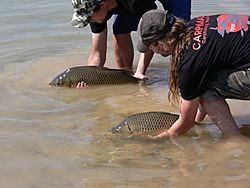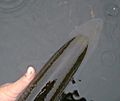Catch and release facts for kids
Catch and release is a popular way of fishing where you carefully let the fish go after catching it. It's a special practice in sport fishing that helps protect different kinds of fish. When a fish is caught, the fisherman gently takes the hook out of its mouth. Then, without hurting the fish, they quickly put it back into the water alive. If they need to weigh or measure the fish, they often do it while the fish is still in the water. Using hooks without barbs makes it even easier to release the fish without taking it out of the water at all.
Catch and release is a choice many fishermen make, but it's not right for every situation. For example, the Snakehead fish is an invasive species. This means it's not native to an area and can harm the local environment. Because of this, it's illegal in many places to put them back in the water. The Muskellunge is a highly valued game fish in many areas. However, in some places, it's also seen as an invasive species and should not be returned to the water.
Contents
Why Fishermen Choose Catch and Release
This method helps keep fish populations healthy. By releasing fish, especially the bigger ones, they can continue to breed and make more fish. This means there will be plenty of fish for everyone to enjoy for a long time. It's a way to enjoy fishing while also protecting nature.
Debates About Catch and Release
People have different ideas about catch and release fishing. In Canada, many First Nations people believe that fish should only be caught when needed for food. They feel that "playing with the fish" doesn't show proper respect. However, many sport fishermen say that catch and release is respectful because they only take what they need and let the rest go. This helps keep fish populations strong.
Is Fishing Painful for Fish?
Some people who care about Animal protection worry that fishing might cause suffering for fish. A fish that gets hooked in its gills or stomach might not survive after being released. To reduce harm, fishermen can use hooks without barbs or hooks that dissolve quickly. This helps if the hook can't be removed. However, a fish can be caught multiple times by different fishermen. Handling a fish many times might not be the best way to manage natural resources or be kind to the fish.
Even some fishermen have concerns. They argue that once a fish has been caught, it's no longer truly wild. They might wonder if it's as exciting to catch a fish that others have already caught.
How Many Fish Survive?
Despite these debates, catch and release remains very popular among many fishermen and fish biologists. People who support catch and release often quote a famous fisherman named Lee Wulff, who said: "A trout is too valuable to be caught only once." Studies show that very few fish die after being released, usually only 2 to 5 percent, when caught with artificial lures. But when live bait is used, about 50 percent of the fish might not survive. This shows that using artificial bait is a big part of successful catch and release.
Images for kids
-
Releasing a rod-caught Atlantic salmon on the Little Gruinard in Wester Ross, Scotland
-
"No Barbs" sign on Ribnik river in Bosnia and Herzegovina
See also
 In Spanish: Captura y suelta para niños
In Spanish: Captura y suelta para niños








